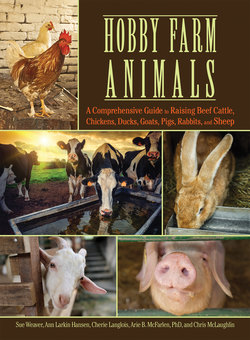Читать книгу Hobby Farm Animals - Chris McLaughlin - Страница 13
На сайте Литреса книга снята с продажи.
Beef Cattle Behavior and Handling
ОглавлениеAlthough they are not as bright as dogs and cats, cattle are intelligent in their own way. Usually good at taking care of themselves, they’ll find a windbreak when it’s cold and shade when it’s hot, and they’ll never forget where their calves are. While cattle learn more slowly than horses, they do quickly learn to come when called if you reward them with grain or a new pasture when they get there. And when they learn something, they never forget it—especially bad experiences, which is an important point to remember when you’re working cattle. When introduced to new experiences slowly and patiently, they’re also quite curious. If I walk into the pasture and sit down, I’m soon closely surrounded by a ring of sniffing cows, wondering what in the world I’m doing.
Cattle are not democratic. In every herd, there is a hierarchy, from the bossy top cow to the shy one at the bottom of the pecking order that always gets shoved away from the best feed. Dominance is determined by strength and aggressiveness, but it’s all kind of low key. Cows don’t fight so much as they test to see who can push whom around. You’ll sometimes see a pair of cows head-to-head, hooves planted, just pushing. The winner is the one that pushes hardest and longest. Cows will push around a young bull, too. (Don’t worry, he’ll get over it.)
Cows have different personalities. One of the delights of having a small herd of cattle is getting to know each cow on an individual level. Some are inherently nervous and will never let you get close. Some are docile and like their heads scratched, while others like to spend most of their time shoving everyone else around. Some are overprotective mothers, while others are lackadaisical about their calves. Most will nurse only their own calves, but a few will let any calves help themselves—kind of like those human mothers we fondly remember from our childhoods who would feed any of the neighborhood kids who happened to be around at dinnertime.
Some behaviors are common to all cattle. Because they are, and always have been, a prey species, cattle are hardwired to run at any sign of danger. Danger, to nervous cows, could be anything from a strange human in the pasture to a funny smell. They don’t stop to think about whether there is really a threat; they just take off. They’ll run right over you if they’re in a panic, and they panic fairly easily. For animals that are normally fairly slow moving and clumsy, they can move surprisingly fast when frightened or agitated, and they’ll jump gates and fences—or trample them.
Cattle would rather run than fight, but they will also fight if they have to. A cow will defend its calf; a bull that decides for some reason that a person is competition or a threat will charge and can kill that person. Although when kept with the cows, beef bulls will usually behave themselves and run away with the cows, they are naturally more aggressive than cows, and they are unpredictable. You can’t trust a bull not to charge you instead of running away. Never, ever, turn your back on a bull.
As a prey species, cattle learned long ago that there is safety in numbers. They graze in a group because it’s easier for a group to spot and defend itself against predators than it is for a single animal. The herding instinct is not completely dominant, however. Groups of two or three will wander off, although usually not too far, from the main herd in pursuit of some promising grazing.
If the pasture is large enough, cows prefer to go off by themselves to calve and may remain away for a day or two before returning with their new babies. Cows also use babysitters. Often, you’ll see a single cow watching over a group of calves while all of the other mothers are off grazing and, I presume, gossiping.
